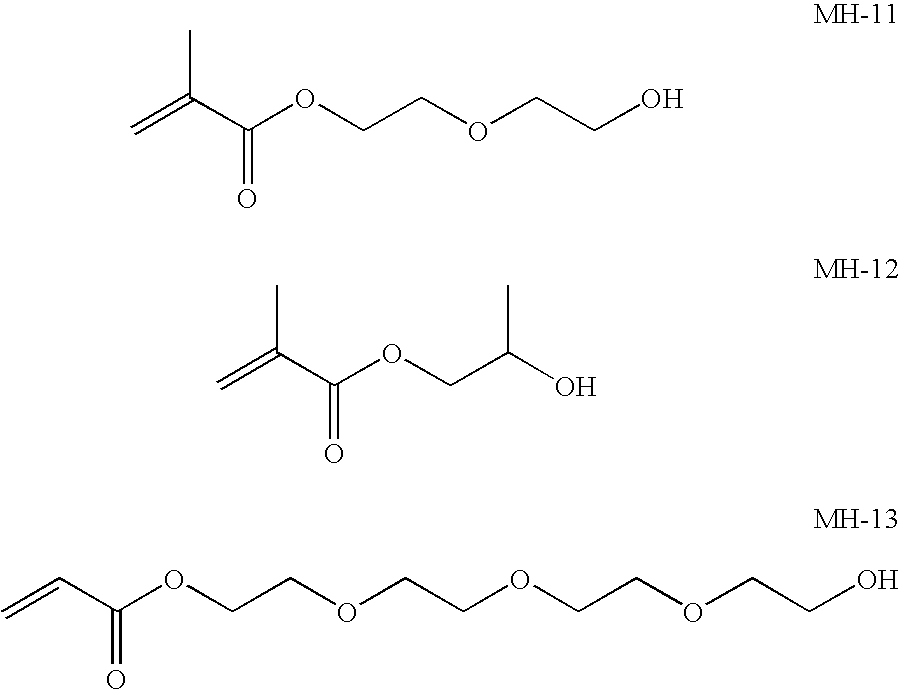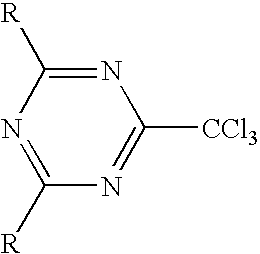Light sensitive composition and light sensitive planographic printing plate precursor
a technology of light-sensitive composition and precursor, which is applied in the field of light-sensitive composition and light-sensitive planographic printing plate precursor, can solve the problems of reducing sensitivity, reducing sensitivity, and spectral sensitization to suit the wavelength of laser ray to obtain high sensitivity, etc., and achieves easy enhancement of optical system precision, high density recording, and improved adhesion.
- Summary
- Abstract
- Description
- Claims
- Application Information
AI Technical Summary
Benefits of technology
Problems solved by technology
Method used
Image
Examples
example 1
>
[0133]Thirty parts of methacrylic acid, 50 parts of methyl methacrylate, 10 parts of acrylonitrile, 10 parts of ethyl methacrylate, 500 parts of ethanol, and 3 parts of α,α-azobisisobutylonitrile were put in a three neck flask under nitrogen atmosphere, and reacted under nitrogen atmosphere for 6 hours at 80° C. in an oil bath. After that, the reaction mixture was refluxed at a boiling point of isopropyl alcohol for one hour, and 3 parts of triethylbenzylammonium chloride and 25 parts of glycidyl methacrylate were further added to the mixture, and reacted for additional 3 hours. Thus, acryl copolymer 1 was obtained. The weight average molecular weight of the acryl copolymer 1 was 35,000, measured according to GPC. The glass transition temperature Tg of the acryl copolymer 1 was 85° C., measured according to DSC (differential thermal analysis). The mixture was heated to 160° C. for 3 hours to obtain a solid. The solid content of the mixture was 20% by weight, which was obtained from...
example 2
[0151]Light sensitive planographic printing plate precursor samples 21 through 27 were prepared in the same manner as in Example 1 above, except that the following photopolymerizable light sensitive layer coating liquid 2 was used instead of the photopolymerizable light sensitive layer coating liquid 1
[0152]
(Photopolymerizable light sensitive layer coating liquid 2)Acryl copolymer 140.0partsSpectral sensitizing dye 31.0partSpectral sensitizing dye 41.0partSpectral sensitizing dye 51.0partTetrabutylammonium butyl trinaphthyl4.0partsBorateTriazine (as shown in Table 2)1.0partAddition polymerizable ethylenically20.0partsunsaturated bond-containing monomer(as shown in Table 2)NK OLICOU-4HA (produced by10.0partsShinnakamura Chemical Co., Ltd.)NK ESTER-4G (produced by10.0partsShinnakamura Chemical Co., Ltd.)Phthalocyanine pigment6.0parts(MHI 454 produced by Mikuni Sikisosha)2-t-Butyl-6-(3-t-butyl-2-hydroxy-0.5parts5-methylbenzyl)-4-methylphenyl acrylate (Sumirizer GS producedby Sumitomo 3...
PUM
| Property | Measurement | Unit |
|---|---|---|
| temperature | aaaaa | aaaaa |
| temperature | aaaaa | aaaaa |
| temperature | aaaaa | aaaaa |
Abstract
Description
Claims
Application Information
 Login to View More
Login to View More - R&D
- Intellectual Property
- Life Sciences
- Materials
- Tech Scout
- Unparalleled Data Quality
- Higher Quality Content
- 60% Fewer Hallucinations
Browse by: Latest US Patents, China's latest patents, Technical Efficacy Thesaurus, Application Domain, Technology Topic, Popular Technical Reports.
© 2025 PatSnap. All rights reserved.Legal|Privacy policy|Modern Slavery Act Transparency Statement|Sitemap|About US| Contact US: help@patsnap.com



